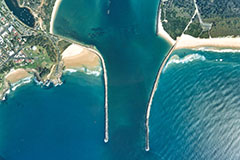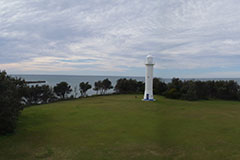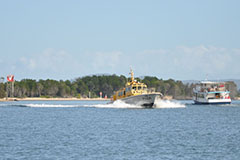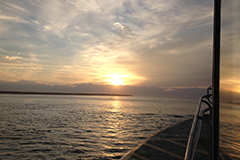Pilotage is compulsory for all vessels 30m and over in length, unless exempted under section 75 of the Marine Safety Act 1998.
Harbour Master's Directions
The Port of Yamba Harbour Master has powers under the Marine Safety Act 1998 to direct and control the time and manner in which any vessel may enter, leave or move in the port. The Harbour Master's Directions are applicable to trading, commercial and recreational vessels, Masters, crews and owners. Additional information can be found in Port of Yamba Harbour Master's Port Information and guidance for Agents.
Pilotage
The port is a 24 hour port with a Vessel Information Service available for known arrival and departures outside business hours.
The length for tug and tows is the combined length of the towing vessel LOA and vessel(s) being towed LOA, regardless of the configuration.
In accordance with the Harbour Master's Directions, private vessels with a draft exceeding 3m or a length exceeding 45.72m are considered “sea-going ships” and are required by the port to engage a pilot. Masters not familiar with the port are encouraged to engage a pilot as local knowledge will not be provided by radio or telephone.
Preliminary arrangements for a pilot must be made with the Port through an agent (local or ShIPS registered).
Sydney's Integrated Port System (ShIPS) is the method used by Port of Yamba to process vessel bookings in and out of the port by coordinating the requirements of agents, pilots, tugs, linesmen as required, lodge Dangerous Goods cargos and manifests, Work and Bunker Permits.
For more information and a login for your organisation, please contact the Shipping Manager
phone: +61 2 6646 2002
email [email protected]
Links to ShIPS information and procedures:
Applicable vessels requiring entry to the port must submit an ‘expected’ arrival notice via the SHiPS system both 72 hours and then 48 hours before arrival, noting that non-standard entries such as tows or disabled vessels are to make enquiries to the port with as much notice as possible to enable assessment of the intended arrival.
Applicable vessels must be booked into the SHiPS system not less than 24 hours before arrival with the final notice prior to a pilot boarding time to be made by 1500hrs the previous day.
For all movements, confirmation of the intended movement must be made by the vessel not less than one hour before expected arrival. This will be via VHF communications through to the port Vessel Information Service.
Notification of movements over a weekend through to the midday on the following Monday or public holiday must be received by 12:00 on the Friday or day preceding. Except in exceptional circumstances, notification to the Port to amend a pilot booking cannot be made between 1900 and 0700 on any day.
For removals and departures, a vessel movement request is to be booked in the SHiPS system no later than 24 hours prior to the movement noting that the final notice prior to a pilot boarding time is to be made by 1500hrs the previous day.
A cancellation charge may apply where a pilotage booking is amended or cancelled within 2 hours of a booked pilot boarding time.
Delay charges accrue after one hour from the nominated time of booking. A pilotage may be deferred if the vessel is not ready and the pilot leaves the vessel.
Vessels are to call ‘Yamba Harbour’ one hour before arrival or booked pilot time, confirming estimated time of arrival, draft and security level. The port utilises the following marine VHF channels:
- 16 and 11 for initial calling
- 11 for calling, port monitoring and pilot transfers
- 10 for port working (port assigned) and
- 09 for port working (port assigned)
Once contact is established vessels are to maintain watch on VHF 11 for pilot vessel approach and instructions.
Pilot station mobile: +61 419462002
The established pilot boarding areas are:
North – Outer (29º 24•63‟S 153º 24•21‟E): Located 2 mile NE of the end of the south breakwater this PBG is for use by all vessels unless advised otherwise by the Port VIS or assigned pilot;
North – Inner (29º 25•17‟S 153º 23•24‟E): Located 1 mile NE of the end of the south breakwater this PBG is by assignment only;
South East (29º 26•02‟S 153º 22•74‟E): Located 0.5 mile SE of the end of the south breakwater this PBG is by assignment only; and
Harwood Bridge (29º 25•85′S 153º 14•25′E): Located 0.20 miles upstream of the Harwood Bridge.
A vessel manoeuvring to embark a pilot should maintain a speed of about seven (7) knots and steer a course which puts the prevailing swell on the opposite quarter to the side on which the boarding arrangement is rigged.
Cross swells are a common occurrence and can cause delays to boarding. The Master of an arriving vessel should always ensure sufficient sea-room is maintained to allow manoeuvres to provide a lee for the pilot cutter and departure from the Pilot Boarding Ground.
Vessels are to monitor VHF channels 16 and 11 for calling by the pilot vessel on approach. Vessels must not proceed any closer than the ‘North – Outer’ PBG without permission of the Port.
To avoid possible delays or miss a tidal slot, masters should take note of the following requirements:
- boarding arrangement are to be rigged in accordance with SOLAS Chapter V, Reg 23, and IMO Res A.1045(27)
- ladder or access point is to be rigged on the lee side to the swell when approaching the PBG
- lowest point of the ladder to be 2 metres above the water
- two proper manropes without knots or monkeys fists must be provided at all times
- no tripping lines are to be attached to the pilot ladder below the lowest spreader.
Vessels with obstructed, non-compliant or alternate arrangements are to advise the port via the Agent not less than 48 hours prior to arrival. Due to such configurations, these will be assessed on a case by case basis and may result in boarding during daylight only.
Boarding of tugs with or without tows will be assessed on a case by case basis as per non-compliant arrangements. All towed vessels over 50m LOA are to have arrangements for access and boarding in smooth waters and this is to be rigged before arrival
Tow arrangement needs to be sent to the port well in advance to ensure there are no delays on arrival and pilot boarding.







